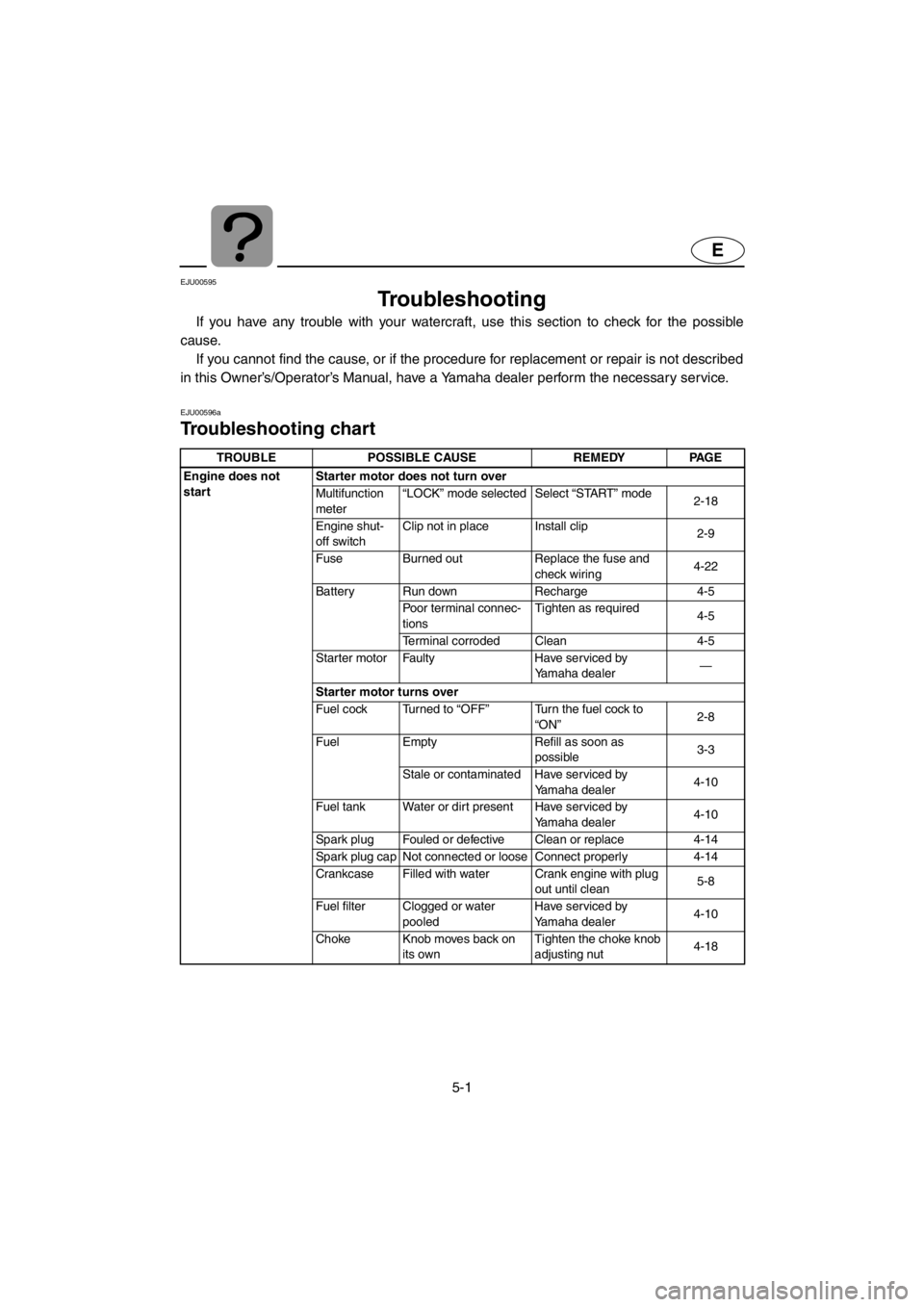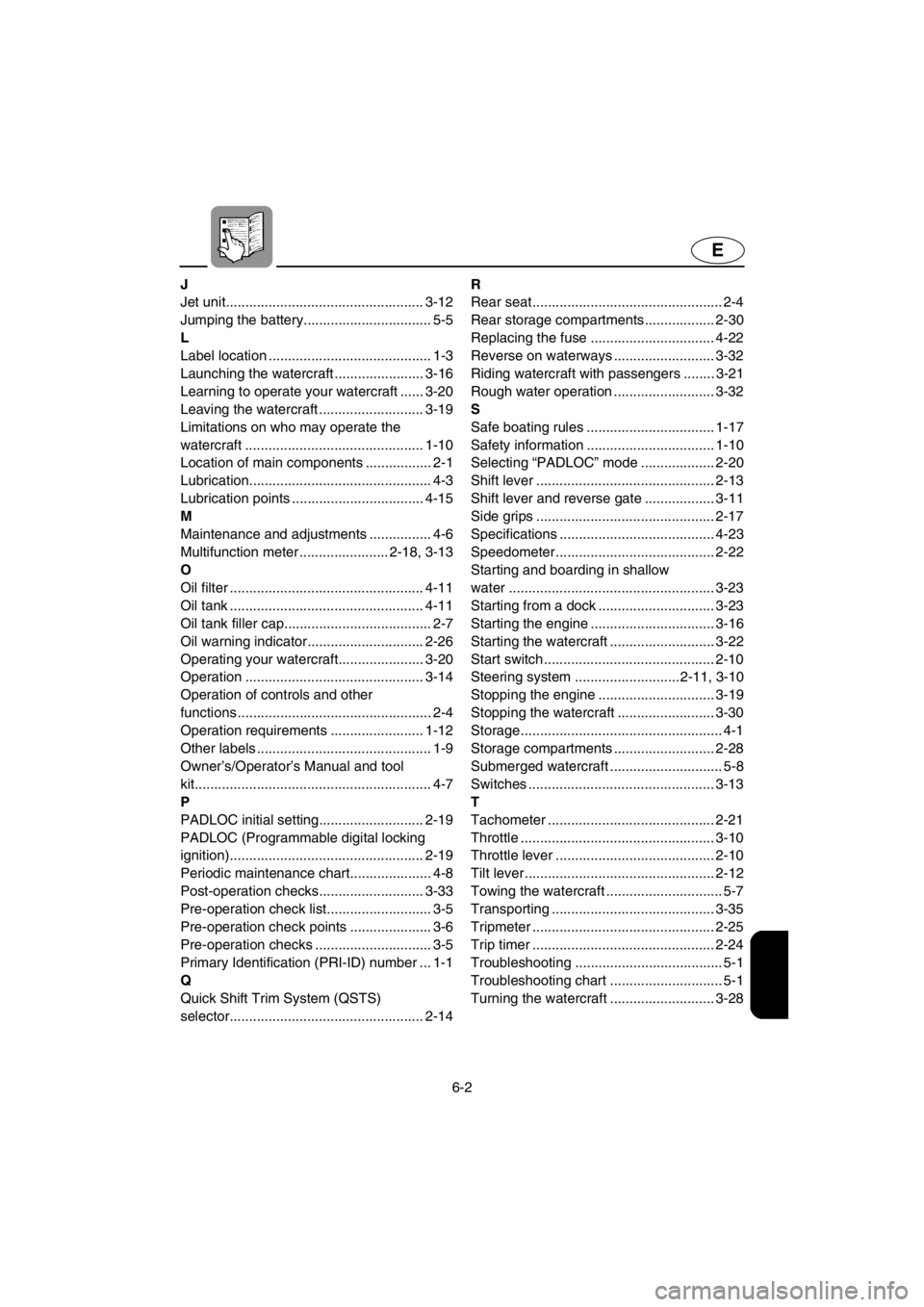check engine YAMAHA SUV 1200 2001 Owner's Manual
[x] Cancel search | Manufacturer: YAMAHA, Model Year: 2001, Model line: SUV 1200, Model: YAMAHA SUV 1200 2001Pages: 135, PDF Size: 21.67 MB
Page 99 of 135

4-4
E
EJU00946
Fuel system
Draining the fuel system prevents buildup
of varnishes and other harmful deposits that
result when gasoline sits for a prolonged
period of time.
WARNING@Gasoline is highly flammable and explo-
sive. A fire or explosion can cause
severe injury or death. Shut the engine
off. Refuel in well-ventilated areas away
from flames or sparks. Do not smoke.
Avoid spilling gasoline. Wipe up spilled
gasoline immediately.
@
To drain the fuel system:
1. Place the fuel cock knob in the “OFF”
position.
2. Drain the fuel tank using a siphon.
EJU00530
Battery
When the watercraft is not to be used for
a month or more, remove the battery and
store it in a cool, dark place. Clean the bat-
tery casing using fresh water. Clean the bat-
tery terminals. Apply dielectric grease or
petroleum jelly to the battery terminals and
to all exposed battery leads.
If the battery is to be stored for a longer
period, check the specific gravity of the elec-
trolyte at least once a month and charge the
battery if necessary.
Specific gravity: 1.28 at 20 °C (68 °F)
E_GU5-71-4.fm Page 4 Thursday, July 13, 2000 7:54 PM
Page 120 of 135

5-1
E
EJU00595
Troubleshooting
If you have any trouble with your watercraft, use this section to check for the possible
cause.
If you cannot find the cause, or if the procedure for replacement or repair is not described
in this Owner’s/Operator’s Manual, have a Yamaha dealer perform the necessary service.
EJU00596a
Troubleshooting chart
TROUBLE POSSIBLE CAUSE REMEDY PAGE
Engine does not
startStarter motor does not turn over
Multifunction
meter“LOCK” mode selected Select “START” mode
2-18
Engine shut-
off switchClip not in place Install clip
2-9
Fuse Burned out Replace the fuse and
check wiring4-22
Battery Run down Recharge 4-5
Poor terminal connec-
tionsTighten as required
4-5
Terminal corroded Clean 4-5
Starter motor Faulty Have serviced by
Yamaha dealer—
Starter motor turns over
Fuel cock Turned to “OFF” Turn the fuel cock to
“ON”2-8
Fuel Empty Refill as soon as
possible3-3
Stale or contaminated Have serviced by
Yamaha dealer4-10
Fuel tank Water or dirt present Have serviced by
Yamaha dealer4-10
Spark plug Fouled or defective Clean or replace 4-14
Spark plug cap Not connected or loose Connect properly 4-14
Crankcase Filled with water Crank engine with plug
out until clean5-8
Fuel filter Clogged or water
pooledHave serviced by
Yamaha dealer4-10
Choke Knob moves back on
its ownTighten the choke knob
adjusting nut4-18
E_GU5-71-5.fm Page 1 Thursday, July 13, 2000 7:55 PM
Page 123 of 135

5-4
E
EJU00597
Emergency procedures
EJU00598
Cleaning the jet intake and
impeller
If weeds or debris get caught in the intake
or impeller, cavitation can occur, causing jet
thrust to decrease even though engine
speed rises. If this condition is allowed to
continue, the engine will overheat and may
seize. If there is any sign that the jet intake
or impeller is clogged with weeds or debris,
beach the watercraft and check the intake
and impeller. Always stop the engine before
beaching the watercraft.
WARNING
Before attempting to remove weeds or
debris from the jet intake or impeller
areas, shut the engine off and remove
the clip from the engine shut-off switch.
Severe injury or death could result from
contact with the rotating parts of the jet
pump.
1. Turn the watercraft on its side as shown.
CAUTION:
●Place a suitable clean cloth or carpet-
ing underneath the watercraft to pro-
tect it from abrasions and scratches.
●Always turn the watercraft over onto
its port (left) side.
●When turning the watercraft on its
side, support the bow so the handle-
bars cannot be bent or damaged.
E_GU5-71-5.fm Page 4 Thursday, July 13, 2000 7:55 PM
Page 131 of 135

6-2
E
J
Jet unit................................................... 3-12
Jumping the battery................................. 5-5
L
Label location .......................................... 1-3
Launching the watercraft ....................... 3-16
Learning to operate your watercraft ...... 3-20
Leaving the watercraft ........................... 3-19
Limitations on who may operate the
watercraft .............................................. 1-10
Location of main components ................. 2-1
Lubrication............................................... 4-3
Lubrication points .................................. 4-15
M
Maintenance and adjustments ................ 4-6
Multifunction meter ....................... 2-18, 3-13
O
Oil filter .................................................. 4-11
Oil tank .................................................. 4-11
Oil tank filler cap...................................... 2-7
Oil warning indicator.............................. 2-26
Operating your watercraft...................... 3-20
Operation .............................................. 3-14
Operation of controls and other
functions .................................................. 2-4
Operation requirements ........................ 1-12
Other labels ............................................. 1-9
Owner’s/Operator’s Manual and tool
kit............................................................. 4-7
P
PADLOC initial setting........................... 2-19
PADLOC (Programmable digital locking
ignition).................................................. 2-19
Periodic maintenance chart..................... 4-8
Post-operation checks........................... 3-33
Pre-operation check list........................... 3-5
Pre-operation check points ..................... 3-6
Pre-operation checks .............................. 3-5
Primary Identification (PRI-ID) number ... 1-1
Q
Quick Shift Trim System (QSTS)
selector.................................................. 2-14R
Rear seat................................................. 2-4
Rear storage compartments .................. 2-30
Replacing the fuse ................................ 4-22
Reverse on waterways .......................... 3-32
Riding watercraft with passengers ........ 3-21
Rough water operation .......................... 3-32
S
Safe boating rules ................................. 1-17
Safety information ................................. 1-10
Selecting “PADLOC” mode ................... 2-20
Shift lever .............................................. 2-13
Shift lever and reverse gate.................. 3-11
Side grips .............................................. 2-17
Specifications ........................................ 4-23
Speedometer......................................... 2-22
Starting and boarding in shallow
water ..................................................... 3-23
Starting from a dock .............................. 3-23
Starting the engine ................................ 3-16
Starting the watercraft ........................... 3-22
Start switch............................................ 2-10
Steering system ...........................2-11, 3-10
Stopping the engine .............................. 3-19
Stopping the watercraft ......................... 3-30
Storage.................................................... 4-1
Storage compartments .......................... 2-28
Submerged watercraft ............................. 5-8
Switches ................................................ 3-13
T
Tachometer ........................................... 2-21
Throttle .................................................. 3-10
Throttle lever ......................................... 2-10
Tilt lever ................................................. 2-12
Towing the watercraft .............................. 5-7
Transporting .......................................... 3-35
Tripmeter ............................................... 2-25
Trip timer ............................................... 2-24
Troubleshooting ...................................... 5-1
Troubleshooting chart ............................. 5-1
Turning the watercraft ........................... 3-28
E_GU5-71IX.fm Page 2 Thursday, July 13, 2000 7:56 PM